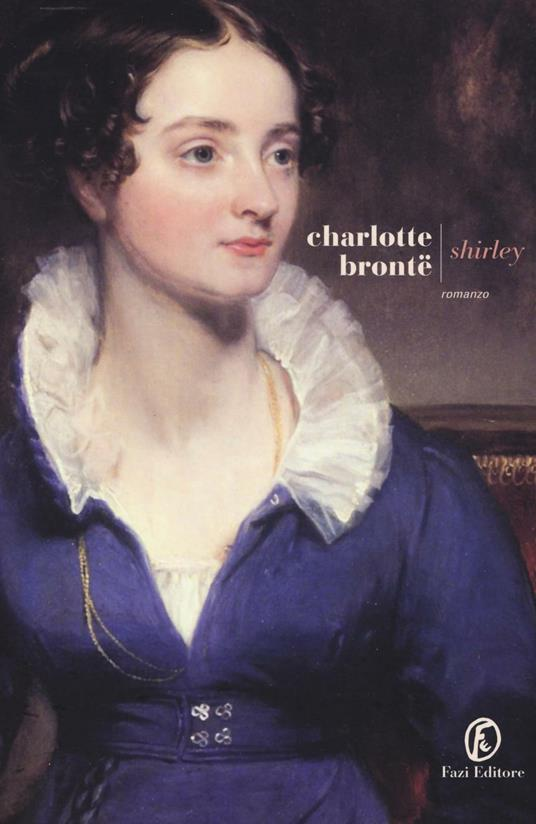
https://www.ibs.it/shirley-libro-charlotte-bronte/e/9788893250252
The novel was first published in 1849. It is a 684-page book, but for me, it ended too soon because I would have liked to know much more about the past and the future of the beautiful characters portrayed by Charlotte Brontë, an English writer best known for her novel "Jane Eyre," from which the Italian director Franco Zeffirelli created a memorable film in 1996. Unfortunately, the writer died at the young age of 39, without having the opportunity to write many more books, but her story and that of her unfortunate family still live on in the memories of all literature lovers. Charlotte Brontë was born in Britain, in Yorkshire, in 1816, and was the older sister of Emily and Anne Brontë, also writers. Charlotte's two older sisters died prematurely at the ages of 10 and 11, after falling ill due to the poor sanitary conditions of the Cowan Bridge Institute, a girls' school for the daughters of clergymen where their father, a clergyman, sent all his daughters to study. The infamous institute would be recalled years later by Charlotte in her most famous novel: contemporary readers didn't fail to identify Lowood School, where Jane Eyre is sent, with Cowan Bridge. Charlotte, after witnessing the illness and death of her two younger sisters and brother Branwell, married Reverend Nicholls in 1854. Unfortunately, she died in Haworth in March 1855, pregnant with her first child. The village of Haworth in the Yorkshire and Humber regions is now famous primarily as the place where the famous but unfortunate Brontë sisters lived. This brief bibliographic introduction was necessary to understand how even in the novel "Shirley," it is possible to find elements that refer to Charlotte Brontë's existential experience. The novel is set in a small village in Yorkshire in the early nineteenth century, during the industrial revolution and the Napoleonic Wars. The story unfolds over about a year and is narrated chronologically. Everything revolves around the lives of two young women, Caroline and Shirley, and their relationships with the Moore brothers. Robert Moore is a textile entrepreneur who intends to make improvements to his company and earnings through mechanization. However, the reaction of his workers is hostile. In the machines, they see not a symbol of progress but the cause of unemployment and misery affecting those laid off and replaced by machinery. His brother, Louis Moore, works as a tutor for Shirley's family, taking care of her education and that of her cousin. Shirley, the character who gives the novel its name, is an orphaned 21-year-old heiress with an unstable character. Caroline is the young niece of Reverend Mr. Helstone, with whom she lives since, at the beginning of the book, we learn that she is fatherless and her mother has fled, missing; we do not know if she is still alive. She is a shy, reserved girl who passively endures events, introverted to the point of silently suffering loneliness for most of the novel. She is the opposite of Shirley. Gradually, a series of characters appear in the novel, populating the small community. The author gives them a voice to express their ideas and political positions on the issues raised by the book. The events are narrated by the author, leaving ample space for dialogues and inner reflections by the different characters. This is not a romance novel aimed at a female audience, but a social novel addressed to a readership of different socio-economic backgrounds and genders. The themes addressed are those that somehow marked Charlotte Brontë's life but probably characterize everyone's life, even readers of the twenty-first century. The novel discusses the Luddite movement, technological progress, and the consequences of such innovations on the employment conditions of workers at the bottom of the social pyramid, who risk unemployment and the inability to provide for themselves and their families with basic necessities. Money is a recurring theme, including the possibility of marrying a loved one, as the author, without hypocrisy or utopian romanticism, shows how building a marital relationship and a happy family also depends on the availability of the economic resources needed to ensure a decent life. Despite this aspect, the novel also discusses the role of feelings within a couple's relationship and the issue of marriages entered into for purely economic and social convenience. The novel addresses the issue of the female condition and whether women can freely choose to marry or remain single, take care of others, or travel and achieve professional fulfillment, gaining full control over their lives and economic independence. Therefore, the novel explores the female universe in its various facets, thanks to a range of female characters who gradually appear on the scene. Caroline, in particular, confronts them, wondering what kind of woman she would or could become. This book expresses, in some parts, a claim to the dignity and right to autonomy of women, a theme unfortunately still relevant. The novel prompts us to reflect on loneliness and our relationship with illness and death, which are constantly ready to appear in each of our lives and that we will somehow have to face, as happens to the characters in this story and as happened to the author's family. I appreciated reading this novel precisely because of the absence of improbable and exaggerated romanticism and the presence of a lucid and realistic description of the society of the time and human thought and experience, which remains, in many parts, fundamentally unchanged almost two centuries later, especially regarding feelings and the relationship with illness and death. The pace of the narrative is not constant because there are phases where it slows down, while the ending, from my point of view, is a bit rushed. I would have liked a deeper psychological exploration of the character of Robert Moore and more information about Shirley's past and Caroline's parents, whose tragic story is barely outlined and suggested. The strengths of the book lie in the descriptions of the English setting and the parts dedicated to introspection, which are very believable and emotional. The characters, complex and ambiguous, are masterfully outlined in their characteristics, and it is difficult to forget them after finishing the reading. However, I missed something, a completeness that could fully satisfy me: I would have preferred fewer slow or descriptive parts and more actions, using these splendid characters. Some mention is also made of the future of some minor characters, but everything is left hanging. Therefore, the ending does not provide all the answers one would expect. The beginning of the book seems, at first glance, less impactful and engaging: it is necessary to resist and continue until Caroline, Robert Moore, and all the others come on stage, and the story begins to be more interesting. I recommend this book to those who love nineteenth-century English literature because it will not disappoint with the peculiarities of its characters and the themes addressed. After finishing reading, it will leave you with many issues to reflect on and discuss. SOURCES:
Immagine di Freepik
Brontë, C. (1849). "Shirley". Fazi Editore, Rome, (2015).
Wikipedia: https://en.wikipedia.org
Fazi Editore Website: https://fazieditore.it/catalogo-libri/shirley/
Wow 1849, I could really imagine how really old that book and I guess it is really good to read.
Absolutely! "Wuthering Heights" by Emily Brontë is indeed a classic piece of literature that was first published in 1847. It's considered one of the greatest novels of English literature.
Wow, I wish I could read that book. Sounds very interesting.
Congratulations @butterfly-jt9! You have completed the following achievement on the Hive blockchain And have been rewarded with New badge(s)
Your next target is to reach 50 comments.
You can view your badges on your board and compare yourself to others in the Ranking
If you no longer want to receive notifications, reply to this comment with the word
STOPTo support your work, I also upvoted your post!